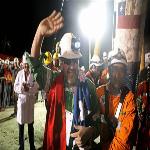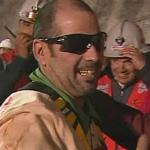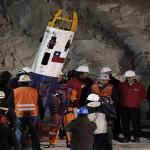2010-10-15

Photo: AP
Luis Urzua just after his rescue. He was the last miner to be taken out of the San Jose mine near Copiapo, Chile. Photo released by the Chilean Government
This is IN THE NEWS in VOA Special English.
(SOUND)
Rescue workers at the San Jose gold and copper mine in northern Chile had reason to sing this week. A small hole drilled into the earth became a passage to freedom for thirty-three trapped miners. They spent sixty-nine days underground. "Never have people been trapped for so long so deeply," says a doctor at NASA, the American space agency, which helped in the rescue.
But the chief medical officer for the miners said most are in good enough health to leave the hospital within a day or so. The first three were released from the hospital Thursday night.
For much of the day the miners relaxed with Chilean President Sebastian Pinera. The thirty-two Chileans and one Bolivian still wore special sunglasses to protect their eyes.
A partial mine collapse on August fifth trapped them more than half a kilometer underground. They had to stretch a two-day food supply. For two weeks no one knew if they were alive or dead.
Later, they received supplies and a video link lowered through drill holes. That link was how Ariel Ticona watched his wife give birth to their daughter.
The miners have apparently agreed to share the money they earn from selling their story.
They have already received gifts of money and travel offers. Edison Pena has been invited to the New York City Marathon and to Graceland, the home of Elvis Presley in Memphis, Tennessee. Mr. Pena described how he ran in the mine tunnels to ease the stress. And he led the miners in singing Elvis songs.

AP
Mario Sepulveda was the second miner rescuedThe first miner rescued on Wednesday was Florencio Avalos. The second was Mario Sepulveda, who talked about how the experience tested his faith.
MARIO SEPULVEDA (TRANSLATED): "I was with God and I was with the devil, they fought me, but God won. He took me by my best hand, the hand of God."
The last miner up was Luis Urzua. He was the shift leader when his crew became trapped.
Rescuers used a metal cage to pull the miners to safety in less than twenty-four hours -- faster than expected. The rescue capsule was a half-meter wide and known as the Phoenix.
The Phoenix is an imaginary bird from ancient stories. It bursts into flames but is continually reborn and rises from the ashes.

AP
Chile's President Sebastian Pinera, far right, watches a rescue worker enter the Phoenix capsule to begin the rescue of the 33 trapped minersChile's Navy built the capsule with advice from mining experts and NASA engineers. It worked like an elevator, traveling up and down on a cable through a shaft drilled six hundred twenty-two meters into the rocks.
Workers used a cutting bit made by a small American company, Center Rock. The bit was on a drilling rig made by Schramm, also based in Pennsylvania.
Millions of people around the world watched the rescue. President Obama said he watched the first miner being freed.
More than one thousand journalists traveled to the mine in the Atacama Desert to report on the rescue. They joined family members of the miners and rescue crews housed in an area of tents known as Camp Hope.
(SOUND)
"Very happy," says this man. "Very happy that the boys are coming out. That it ends already, that their suffering and our suffering ends."
And that's IN THE NEWS in VOA Special English. I'm Mario Ritter.
___
Includes reporting by Laurel Bowman, Elizabeth Lee and Brian Wagner